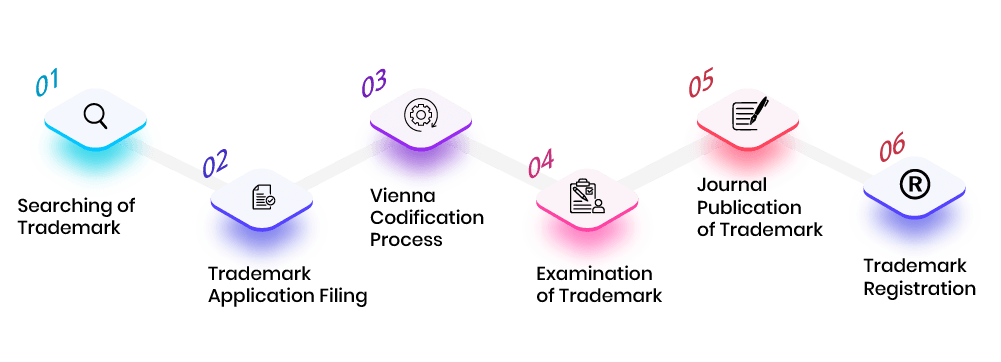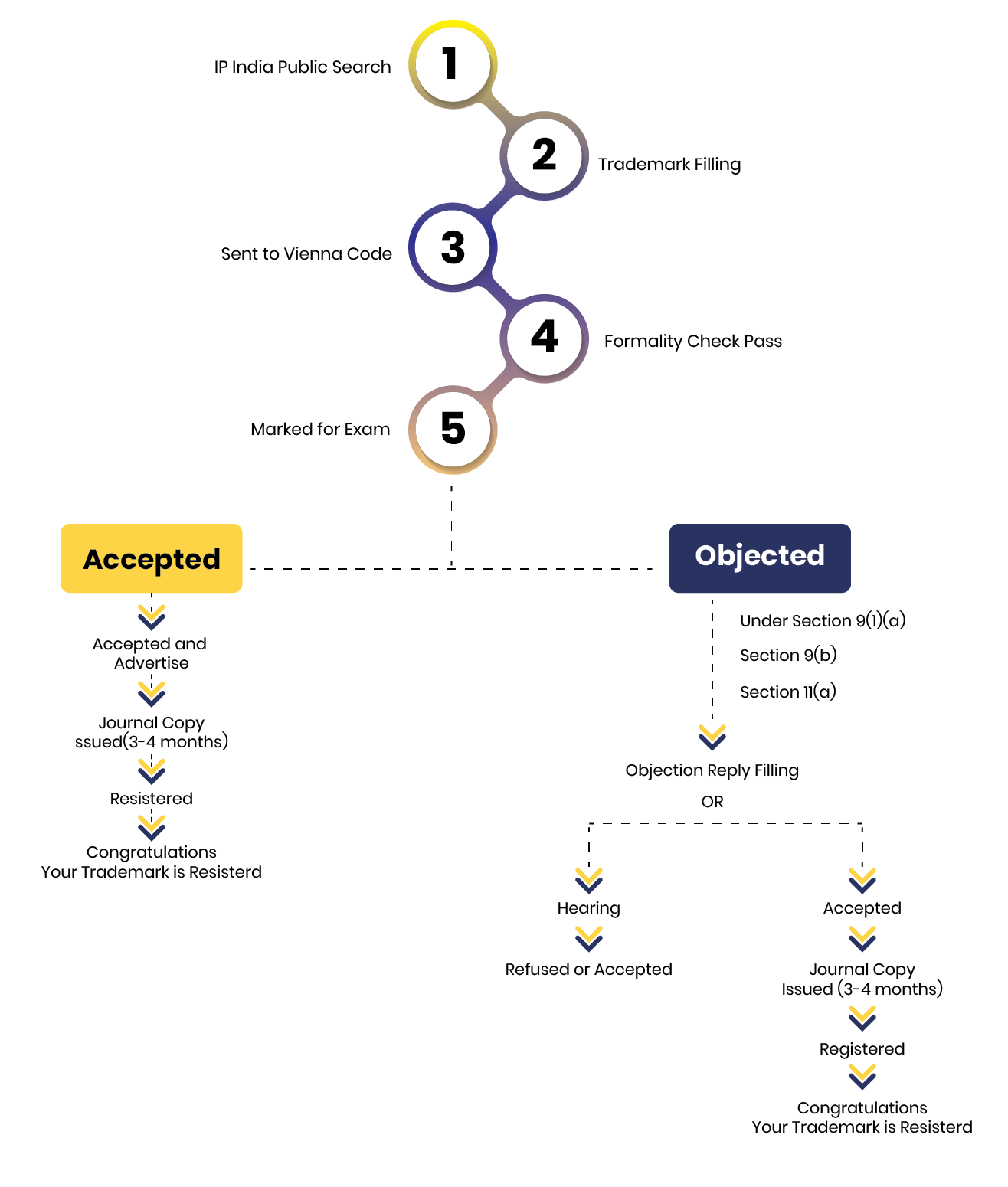Trademark Registration Online
Trademark Registration Online Just @ ₹999 + Govt Fee
Trademark Registration online in India



Trademark Registration Online in India
Trademark registration is a crucial legal process that grants businesses exclusive rights to protect their brand assets, such as names, logos, slogans, and other distinctive identifiers. By registering a trademark, companies can establish a unique identity for their products or services, prevent unauthorized usage by competitors, and gain the ability to take legal action against infringements.
Thanks to advancements in technology, the process of trademark registration has become simpler and more accessible through online platforms. In India, the Trademark Registration Online process can be completed via the official portal managed by the Controller General of Patents, Designs, and Trademarks (CGPDTM). This portal operates under the Ministry of Commerce and Industry’s Department for Promotion of Industry and Internal Trade (DPIIT), offering a streamlined approach to secure intellectual property rights.
What is the Importance of Trademark Registration in India?
The Importance of Trademark Registration in India
Trademark registration is essential for businesses and individuals seeking to protect their unique identity in the competitive market. Here are the key reasons why trademark registration is crucial in India:
- Legal Protection
Registering a trademark provides the owner with exclusive rights to use the mark for the goods or services it represents. This protection prevents unauthorized use of similar or identical marks, reducing the risk of infringement. - Brand Identity
Trademarks play a vital role in creating and maintaining a distinct brand identity. They help consumers recognize and differentiate products or services associated with a specific business, fostering brand loyalty and goodwill. - Business Reputation
A registered trademark enhances a business’s credibility and reputation. It signifies that the brand has met legal standards and is officially recognized by the government. - National Protection
Trademark registration provides protection across India, preventing others from using the registered mark for similar goods or services. This strengthens the owner’s position in the domestic market. - Exclusive Use
Once registered, the trademark owner gains exclusive rights to use the mark for the specified goods or services. This exclusivity ensures a competitive advantage and prevents others from leveraging the brand’s success. - Legal Remedies
A registered trademark offers a legal foundation to take action against infringers. Trademark owners can seek remedies such as injunctions, damages, or even criminal penalties for unauthorized use. - Licensing and Franchising
Registered trademarks can be licensed or franchised, enabling businesses to expand operations and create additional revenue streams while maintaining brand integrity. - Asset Value
A registered trademark is an intangible asset that adds value to a business. It can significantly impact the company’s valuation during mergers, acquisitions, or sales. - International Protection
A registered trademark in India can serve as a basis for seeking protection in other countries through international treaties and agreements, facilitating global business expansion. - Avoiding Disputes
Trademark registration minimizes the risk of disputes with other businesses using similar marks. It helps avoid legal conflicts and the associated costs of litigation.
Online Trademark Registration Eligibility Criteria In India
Eligibility and Requirements for Trademark Registration in India
To successfully register a trademark in India, the following criteria and requirements must be met:
1. Applicant Eligibility
The applicant can be an individual, company, partnership firm, society, trust, or any other legal entity.
The applicant must possess a valid address in India or abroad.
They must have a legitimate interest in the trademark, either as the owner or a licensee.
Trademark Eligibility
The trademark must be distinctive, capable of distinguishing the applicant’s goods or services from others.
It must not be descriptive, generic, deceptive, scandalous, or against any law or morality.
The trademark should not conflict with any existing registered or pending trademarks.
Goods and Services Classification
The goods and services must be classified using the Nice Classification system, which organizes them into 45 distinct classes.
The applicant must identify the relevant class or classes and provide a clear, concise description of each corresponding good or service.
Use in Commerce
The applicant must declare whether they have used or intend to use the trademark in commerce, either in India or abroad.
For trademarks already in use, the applicant must provide the date of first use and supporting evidence, such as invoices, labels, or brochures.
If the trademark is not yet in use, a declaration of bona fide intent to use it in the future must be submitted.
Power of Attorney
The applicant must appoint an agent or attorney to act on their behalf during the registration process.
The agent or attorney must be registered with the Trademark Registry and have a valid address in India.
A signed power of attorney form must be submitted along with the application.
Required Documents and Information
Applicants must provide various documents and details for the online trademark registration process. These typically include:
Identity proof of the applicant (individuals or authorized signatories).
Address proof of the applicant.
A representation or image of the trademark.
A list and description of goods/services for which the trademark is sought.
Proof of use in commerce, if applicable (e.g., invoices, labels).
A signed power of attorney form, if an agent or attorney is appointed.
Documents Required for Trademark Registration in India
To complete the trademark registration process, applicants must provide the following documents and details:
Trademark Application Form (TM-A)
The completed TM-A form, along with the prescribed fees.
Trademark Representation
A clear depiction of the trademark in JPEG format.
Statement of Distinctiveness or Prior Use
If applicable, a statement claiming the distinctiveness of the trademark or evidence of its prior use.
Translation or Transliteration
A translation or transliteration of the trademark if it is not in English or Hindi.
Priority Claim Document
If the applicant is claiming priority based on an earlier application filed in another country, a priority claim document is required.
User Affidavit
An affidavit supporting the claim of prior use of the trademark, if applicable.
Additional Documents
Any other documents or information as requested by the Trademark Registry during the application process.
Documents Needed For Trademark Registration Online In India
Documents Required for Trademark Registration in India
To register a trademark in India, you must submit specific documents alongside your application. These documents help establish your ownership, usage, and eligibility for trademark protection while minimizing objections or opposition. Below is the checklist of required documents:
Trademark Application Form (Form TM-A)
Complete the prescribed application form (TM-A), available on the Indian Trademark Office website or at its physical offices
Applicant’s Details
Provide the name, address, and nationality of the applicant.
For companies or partnership firms, include their legal entity details.
Trademark Representation
Submit a clear depiction of the trademark you wish to register.
This could include a wordmark, logo, device mark, or a combination of these elements.
Trademark Classification
Specify the class or classes of goods and services under which the trademark will be registered.
The classification follows the Nice Classification system based on the nature of goods/services.
Power of Attorney
If you are appointing a trademark agent or attorney, include a signed Power of Attorney authorizing them to act on your behalf.
Proof of Claim (If Applicable)
- If claiming prior use of the trademark in India, provide supporting evidence, such as:Invoices
Bills
Advertisements
BrochuresPriority Document (If Applicable)
Submit the priority document if claiming priority based on an earlier application filed in a convention country.
Government Fees
Pay the applicable government fees for processing the trademark application.
Fees vary based on the type of applicant (e.g., individual, small entity) and the number of classes.
User Affidavit (If Required)Provide a user affidavit if the trademark has been in prior use in India, stating its usage and significance.

Process For Trademark Registration Online

Steps for Trademark Registration
To successfully register your trademark, follow these essential steps:
- Conduct a Trademark Search
- Before applying, perform a comprehensive trademark search to ensure your desired mark is not already registered or pending registration by someone else.
- Use the online database of the Intellectual Property Office in your country or region for this search.
- Determine the class or classes of goods and services your trademark will cover.
- There are 45 distinct classes, each with a specific description.
- Utilize the World Intellectual Property Organization (WIPO) online tool to identify the appropriate class for your trademark.
- Register on the website of the Intellectual Property Office in your country or region.
- Provide basic information such as your name, address, email, and phone number to create your account.
- Log into your account to access the online application form.
- Fill in all required details, including:
- Trademark name.
- Trademark class.
- Owner’s details.
- Declaration of use or intent to use.
- Upload a clear representation of your trademark if it is not a standard word mark.
- Review the completed form for accuracy and submit it online.
- Pay the application fee, which varies based on the number of classes and type of trademark. Payment options include credit card, debit card, or electronic funds transfer.
- After submission, a trademark examiner reviews your application to ensure it meets legal requirements and does not conflict with existing trademarks.
- If no objections are raised, your trademark is published in the official gazette for public notice.
- Once published, there is an opposition period (typically 30 to 60 days) during which others can challenge your trademark registration.
- If an opposition is filed, you will be notified and given the opportunity to respond and defend your trademark.
- If there are no oppositions or you successfully address them, your trademark will be registered.
- You will receive a Trademark Registration Certificate, which serves as proof of your exclusive right to use the trademark for the goods and services registered.

Trademark Objections
Trademark objections may arise during the examination stage of the registration process. These objections are raised by the trademark examiner and are typically based on the following grounds:
- Lack of Distinctiveness
- The trademark is not unique enough to distinguish the applicant’s goods or services from those of others.
- Similarity to Existing Trademarks
- The proposed trademark closely resembles an already registered or pending trademark, potentially causing confusion.
- Descriptiveness
- The trademark merely describes the goods or services and lacks originality or distinctiveness.
- Genericness
- The trademark is a common term or phrase used in the trade and cannot be exclusively claimed.
- Violation of Public Order or Morality
- The trademark is deemed offensive, scandalous, or contrary to public order or accepted principles of morality.
Examination Report
- If objections are identified, the examiner issues an examination report outlining the grounds for objection.
- The applicant is provided with an opportunity to respond to the objections within a specified timeframe.
Responding to Objections
- The applicant can:
- Submit arguments and evidence to address the objections.
- Amend the application to overcome the examiner’s concerns.
Outcome
- If the examiner finds the response satisfactory, the trademark application proceeds to publication in the official gazette.
- If the response does not resolve the objections, the application may be refused.
Trademark Opposition
Trademark oppositions are initiated by third parties following the publication of a trademark application in the official gazette. Any individual or entity that believes the registration of the trademark would adversely affect their rights may file an opposition.
Timeframe for Filing Opposition
- Typically, the opposition must be filed within three to four months from the date of publication.
Grounds for Opposition
The reasons for opposing a trademark registration can vary by jurisdiction but commonly include:
- Prior Rights
- The opposing party claims prior ownership or usage of a similar trademark.
- Bad Faith
- The trademark application is alleged to have been filed with dishonest intent.
- Likelihood of Confusion
- The proposed trademark is too similar to an existing mark, potentially causing consumer confusion.
- Non-Use
- The applicant has not used the trademark in commerce or lacks a bona fide intent to use it.
Opposition Procedure
- Notice of Opposition
- The opposing party files a formal notice detailing their objections to the trademark application.
- Counterstatement by the Applicant
- The applicant responds to the opposition with a counterstatement defending their trademark application.
- Submission of Evidence
- Both parties present supporting evidence and arguments to substantiate their claims.
- Hearing and Decision
- The trademark office or a designated tribunal reviews the submissions, conducts hearings if necessary, and issues a decision.
Possible Outcomes
- Acceptance: The opposition is dismissed, and the trademark proceeds to registration.
- Rejection: The opposition is upheld, and the trademark application is denied.
- Partial Acceptance: The trademark is registered with certain limitations or modifications.
How Someone Can Check Trademark Application In India?
- Visit the Official Website
- Navigate to the Controller General of Patents, Designs, and Trademarks (CGPDTM) official website.
- Login or Register
- If already registered, enter your user ID and password to log in.
- For new users, click on “New User Registration” to create an account by providing the required details.
- Check Trademark Application Status
- To check the status of a trademark application, use the “Trademark Application/Registered Mark Status” option.
- This feature is available under the “Public Search” section on the homepage.
- It does not require login and can be accessed by anyone with the application number or trademark number.
Benefits Related To Trademark Registration Online
- Legal Protection
- A registered trademark grants the owner exclusive rights to use the mark for the specified goods or services.
- It enables the owner to take legal action against infringers and seek remedies such as injunctions, damages, and profits.
- Brand Recognition
- Trademark registration helps build and sustain a distinctive brand identity in the market.
- It fosters customer loyalty and trust while attracting potential customers and investors.
- Business Expansion
- A registered trademark simplifies entering new markets and territories.
- It allows the owner to license or franchise the trademark, creating additional revenue streams and business opportunities.
- Consumer Clarity and Legal Safeguards
- A registered trademark minimizes confusion among consumers and competitors regarding the origin, quality, and features of goods or services.
- It helps avoid legal disputes and challenges from others who may claim similar or identical marks.
FAQ’s
